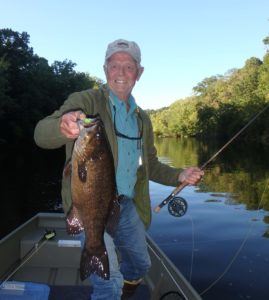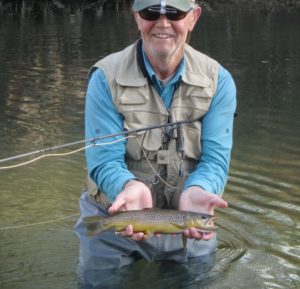
These Fish Required Very Different Flies,

Tackle and Techniques
There are plenty of inherent challenges to becoming an accomplished fly angler. So my goal has always been to make warmwater fly fishing (my specialty) easier and more understandable. To help with this, I think we need to strip away some of the mysticism associated with the sport.
Unfortunately, much of the fly fishing industry is trying to do the opposite. They go out of their way to promote all forms of fly fishing as universally magical, mysterious and very arcane. They do two things that cause newer fly anglers to be confused and stymied.
There is No Such Thing as “Fly Fishing”
The first confusing thing they do is they imply that there is simply “fly fishing.” There are many types of fly fishing, such as fishing for smallmouth with a fly, or using fly tackle for tarpon, or fly fishing for steelhead or for other species. They talk as if these wildly and dramatically different types of fishing are essentially similar because of the type of rod you hold in your hands.
Actually, there is no such thing as just “fly fishing” that you can learn, without knowing what kind of fish you are fishing for. The angling techniques, methods, places, tackle and flies we use for each species are very, very different. So when I hear someone say “I’m going fly fishing” that is as meaningless as one of my fellow Minnesotans saying “I’m going spin fishing.” Do they mean fishing for walleyes or bluegills or muskies? All can be in the same lake, but are dramatically different species and fished in dramatically different ways. So be very leery of any advice or recommendations that simply talks about “fly fishing.” You are pursuing a specific species in specific waters and any advice you receive should make that the primary consideration.
Why is it Mysterious?
The fly fishing biz also makes things difficult is by trying to mystify the sport, making it more complex than it needs to be. They like to talk about very complicated leaders with a profusion of differing sections. They promote many difficult knots that have little value. They make casting a complex exercise in geometry and angles. They even use a dead language (Latin) to describe dozens of different insects. Well, most of this is not necessary. So why the complexity? The intent is to make fly fishing (for any species) seem so detailed and arcane that you, the customer, must solely rely on these gate-keepers for guidance. This way, when they say you need yet another rod, reel, line, leader, fly, video or whatever, you will uncritically accept their recommendations.
Clear and Simple Approach
My approach is different. I try to educate anglers to clearly understand the species they are pursuing, and to better use their tackle for that species. I believe this makes them more productive anglers, and better consumers, too. Fly fishing for smallmouth bass isn’t at all like fishing trout or bonefish or some other species. But it doesn’t have to be overly complicated or confusing. True, learning the single haul so you can easily lay out 45-foot casts is important. But initially you won’t need to learn any fancy casts, and you won’t need the priciest rods or reels. A couple of easy knots are fine. A simple leader system will do and, initially, just a few versatile fly patterns will be sufficient. And no need to gain proficiency in Latin unless you want to impress some trout snobs over drinks.
Smallmouth Fly Fishing
If you want to catch smallmouth, you are not just “fly fishing,” you are smallmouth fly fishing. When many folks say “fly fishing,” they usually mean trout fly fishing, which is a very different sport. Trout-focused tactics like using tiny flies, dead drifting, short casts in fast riffle water, and others are largely ineffective for smallmouth. So leave these ideas at home.
Instead, to catch smallmouth, you will need to learn better casting (and use larger flies). This means using stouter tackle, such as heavier rods (like 7 and 8 weights) and lines a weight or two over the rod rating. You should also work on using better fly retrieves. The simplistic (and often ineffective) steady stripping retrieves aren’t nearly sufficient. Instead, animating your fly with rod-tip action is what’s needed. This makes a fly hop, pop, flutter, twitch and dart, and is what really appeals to smallies and many other non-trout species.
In my upcoming book, 103 Smallmouth Secrets (due out in 2018) I lay out the key techniques, tactics and methods for smallmouth, all in a concise, easy-to-understand format. Until then, get a few good flies, work on your casting and retrieves and don’t worry about all that other hoo-ha you hear about fly fishing.


No comments yet.